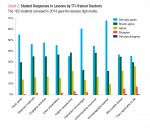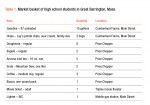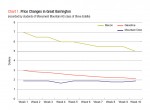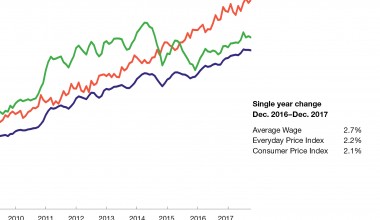Teach the Teachers: Improving Economics Instruction in High Schools
The first Teach-the-Teachers Initiative (TTI) on June 23-27, 2014, covered three topics: “Money and Inflation,” “Business Cycles and Unemployment,” and “Government and the Economy.” Twenty-two teachers attended the program at the AIER campus in Great Barrington, Mass. They came from both public and private institutions. They represented diverse fields of study such as economics, business, mathematics, history, psychology, science, and even Spanish, as well as diverse geographic locations such as Massachusetts, Connecticut, and New Jersey.
High-impact teacher training
The consensus among economic educators is that high-school students learn the most when (1) teachers understand the content, (2) teachers are trained in teaching economics through a well-designed course, and (3) teachers use high-quality curriculum materials. The literature also shows that the most effective workshops for teachers are seminar-style, in-service training. Based on this evidence, the TTI was developed as a residential, five-day workshop, with strong content, based on AIER’s 80 years of expertise, interactive instruction, and lesson demonstrations. The special features of the program are its emphasis on economics across the curriculum, pedagogy, and assessment.
The economics-across-the-curriculum feature is borrowed from the well-known educational practice of studying subjects across disciplines in a coherent and coordinated manner. For example, many schools apply this concept to improve writing skills. Writing across the curriculum gives students the opportunity to practice writing skills while they study many different subjects, such as economics, history, and sociology, as well as biology, chemistry, and physics. Applying one skill (in this case, writing) in different situations reinforces learning. Similarly, within the TTI program we demonstrate how to integrate economic concepts into various disciplines (such as history, sociology, algebra, and science, to name just a few) taught at the high school level.
Teachers build skills
The TTI curriculum is flexible enough to be adopted in English language arts (ELA), social sciences, and math. It allows teachers to use a certain concept, a part of a lesson, or a particular handout for their specific class needs. We introduce many resources for informational texts, data sources, and online activities, so teachers are encouraged to approach their lesson plans creatively, to venture into the interdisciplinary sphere, and to think outside the box. As an outcome of this workshop, teachers develop creative ideas for lessons, teaching approaches, and teaching styles. All of these enhancements in teachers’ skills encourage critical thinking and interdisciplinary knowledge-building in students.
The second special feature of the program is the pedagogy, which encompasses creative approaches to delivering information to students and a variety of delivery methods. TTI uses two pedagogical approaches, Framework for Teaching ®1 and Understanding by Design ®2, which promote active and collaborative learning through various instructional methods and media. The evidence suggests that interactive teaching strategies, real-world applications, and various forms of visualization, communication, and interaction, such as videos, online activities, and using social media such as Facebook and Twitter in the classroom positively affect student learning outcomes. By demonstrating the concepts and requiring interaction with them, TTI assures that learners (in this case, teachers) comprehend the information and develop a deeper understanding, which improves retention.
The third special feature of AIER’s TTI is the assessment of student learning outcomes. The literature recognizes students’ knowledge acquisition and retention, their confidence level, and their future career/major selection as outcomes of the teaching process. Therefore, TTI is focused on exposing teachers to a variety of assessment methods and activities that promote success in different types of learners. For example, TTI discusses innovative approaches to formative assessment, which is an ongoing evaluation of student learning, such as questioning, discussion, exit tickets, learning logs, and presentations. Another assessment method that is conferred is cumulative in nature and is called summative. This method helps teachers understand whether concepts were learned or need to be retaught or taught in a different manner. Examples of traditional summative assessment are state-mandated assessment, district benchmark assessments, and chapter tests.
TTI emphasizes and helps teachers to conceptualize contemporary methods of assessment. The newest method is called “authentic/performance-based assessment.” Its components may include demonstrations, digital images, portfolios, journals, recorded performances, animations, interactive quizzes, video casts, writing samples, and spreadsheets. The authenticity of those projects is assured by students’ use of original data (images, recordings, journals, spreadsheets) and/or creative hands-on approaches (video, animations, and so on).
TTI encourages teachers to integrate all forms of assessment to maximize student learning. This careful integration helps students of all learning styles perform at the best of their abilities, and it informs teachers about what students have learned. Teachers then are able to modify and adjust their instruction both during and after the lesson.
How TTI works
The TTI workshop focuses on three areas of economics—money and inflation, business cycles and unemployment, and government and the economy. At the end of the program, each teacher presents a lesson idea using the economic concepts and teaching and assessment strategies demonstrated during the workshop.
When they are back in their districts, teachers field test their lesson plan, increasing the impact of our educational curriculum to students in actual high school classrooms.
We selected these three topics not only because they are important and most relevant to the general public but also because AIER’s 80 years of experience in assessing and analyzing the data, and writing about these areas provides us with the expertise to present the information in the most interesting and engaging ways.
For the “Money and Inflation” topic, in addition to regular textbook exposition of the functions of money, the Federal Reserve System structure, and inflation calculation, we introduce the AIER Everyday Price Index (EPI). We explain the EPI methodology and direct participants to the EPI Web page, where they can interact with the EPI and download current data comparing the EPI and the Consumer Price Index (CPI).
The second topic, “Business Cycles and Unemployment,” is a cornerstone of AIER’s expertise. The AIER Business-Cycle Conditions (BCC) model is shared with the participants. We explain how AIER monitors economic activity on a monthly basis. We hand out the most current AIER Business Conditions Monthly publication, which serves as the basis for a fruitful discussion about the gross domestic product (GDP), and leading, coincident, and lagging business cycle indicators. We teach unemployment rate calculation by demonstrating a role-play activity.
The third topic that is covered in TTI is “Government and the Economy.” Here, again, we base our instruction on AIER’s publications on property rights, as well as our research and analysis of fiscal policy. The curriculum also includes a discussion of the functions of government, the provision of public goods, and the notion of externalities. We carefully select government Web sites to show the location of current public sector data, and we use games and other interactive activities to inspire interest in understanding the successes and failures of government intervention in the economy.
Implemented lessons
After the economic topics are presented and lessons are demonstrated, participating teachers have the task of coming up with a lesson idea based on the information they learned and on the student constituency of their home classroom. They present this idea during the last day of the program in front of a panel of judges. After the presentation, teachers are encouraged to field-test the idea in the classroom. The creativity of teachers who participated in TTI 2014 resulted in innovative approaches to topic exposition, imaginative pedagogy, and sensitivity to various learning styles. Below are several examples of the lessons implemented by TTI teachers.
Teaching the unemployment rate in a high school math class
On Oct. 6, 2014, we observed the honors algebra class at Mt. Everett High School in the Southern Berkshire Regional School District in Sheffield, Mass., taught by Sarah Siket. The topic of the day was “Slope, Regression Line, and the Trend.”
From an economics viewpoint, the collaborative learning that occurred in this class covered the various types of labor-market participants, showing special cases such as discouraged workers, not-in-labor-force scenarios, part-timers, and retirees. From the mathematics viewpoint, the activities built critical-thinking skills and information text analysis and worked on calculating percentages and the rate of growth.
First, students were exposed to the Federal Reserve Economic Data (FRED) Web site, and they explored population and employment rate data for Berkshire County, Mass., where they live. Students observed and discussed the negative slope of the population trend and connected the population and unemployment situation to their personal life experiences.
The lesson then moved into an active learning exercise about unemploy-ment rate calculation. Students were given “roles” in the economy, such as: full-time student, retiree, temporarily laid-off factory worker, or a job seeker who had stopped looking for work. Other roles were an employed person, a person actively looking for a job, a stay-at-home mom, and so forth. Students had to interview their peers and decide whether the person they interviewed was employed, unemployed, or neither. Based on this information, they were led through the calculation of the unemployment rate appropriate for “their” population.
During our visit we observed exactly what the education literature points out: The interdisciplinary approach to experiential learning is a valuable tool for bringing real-life applications to theoretical subjects.
Teaching fiscal policy in a high school government class
A topic such as the federal budget is too often presented to secondary school students as a subject that involves simple choices. However, one student in the following class reported that the most memorable part of the lesson was “the difficulty that trying to balance the federal budget presented. There were many options and good reasons for each.”
On Oct. 30, 2014, we observed the Advanced Placement government and politics class at Pomperaug High School in Southbury, Conn., taught by Ted Kimble. The topic of the day was “Fiscal Policy.”
The discussion was seeded by the teacher, who introduced the concepts of government expenditures, government revenues, and debt and deficit. It was followed by student questions. The main portion of the class was spent simulating the federal government budgeting process using the federal budget simulation online portal. Students worked individually, with occasional discussion about unfamiliar terms with their peers and the teacher.
After reducing the projected federal budget deficit, each student shared his or her result and offered the rationale for the policy choices they made, identified beneficiaries and sufferers under each scenario, and considered whether it is possible to reduce the federal budget deficit without hurting anyone.
Teaching the quantity theory of money in Spanish class
On Nov. 24, 2014, we observed a Spanish II class at Monument Mountain Regional High School in Great Barrington, Mass. The class was conducted in Spanish by Dan Bouvier.
The topic was market price determination. Students were involved in a demonstration of how prices are set in an actual roadside market in Guatemala, Ecuador, Columbia, Bolivia, or Peru. The lesson in laissez- faire involved various folk objects from Latin American countries (supplied by the teacher) to be traded by active bargaining (in Spanish) by the students. The objects were baskets, knitted goods, blankets, masks, etc. The currency was legal tender bills from the countries (provided by the teacher). Students volunteered to be the seller or the buyer through different rounds of the game.
Underneath the rowdy classroom interactions was an important lesson in economics. The students recorded prices of the goods on the board. As the rounds progressed, they were able to experience and understand how an increase in money supply caused the prices of the goods to rise.
The discussion at the end of the lesson, still in Spanish, focused on factors that determine the price of a good in a market. Many reasons were named, such as the size of an object, the material from which it is made, and its utility. However, students dug deeper and mentioned the state of the economy, the quantity of money, and cultural differences as main factors of the market price determination.
Economics for special education and English-as-a-Second-Language (ESL) students
Learning economics is especially challenging for students with learning disabilities and students who use English as a second language.
We were pleased to work with Kelinda Young from Eastside High School in Paterson, N.J. Kelinda teaches both types of students in the same classroom. Our program provided her with a deeper understanding of economic concepts, which helped her reach both special education and ESL students, who require individualized instruction and highly organized planning. Kelinda put this knowledge to work. She taught her students how to calculate the unemployment rate, but before that, they had to learn the vocabulary of economics.
Kelinda employed a strategy called “Quiz-Trade-Quiz.” This approach provides each student with the vocabulary and definitions on a sheet of paper. The students move around the room and meet in pairs. They quiz each other, giving praise for correct responses and identifying the appropriate term if the response is inaccurate. They then trade their lists and seek out a different student to quiz.
Since this procedure provides lots of interactions with classmates, repetition, and no negative repercussions for incorrect responses, it proved to be an extremely useful tool for her students to learn vocabulary. After this preparation to understand the vocabulary, the students were ready to engage in the interviewing activity (described above for the Sheffield class) for the unemployment rate calculation.
The use of this lesson for students with different learning challenges emphasizes the importance of TTI in providing the teachers with economic knowledge and pedagogical tools to accommodate all existing learning styles. In addition, the flexibility of the TTI curriculum and the variety of recommended assessment methods allow teachers to draw out the best possible student performance.
Building a price index with doughnuts and Mountain Dew
In November 2014, students in Steve Estelle’s financial algebra class at Monument Mountain Regional High School in Great Barrington, Mass., were exploring a very interesting and creative twist on traditional economic indexing. Guided by the AIER Everyday Price Index (EPI), the students went a step further and created a Student Price Index (SPI) focusing on goods and services that are most often purchased by high schoolers.
First, students worked together to figure out which goods and services they buy at least once a week. They opted for the list shown in Table 1. They decided where in Great Barrington to record prices, and exactly which products to monitor, down to the size and packaging options of each brand.
Over the ten weeks that followed the initial lesson, students collected price data from these four businesses in much the same way that the Bureau of Labor Statistics (BLS) collects price data for the U.S. economy. Students used that information to create their Student Price Index, in much the same way that AIER constructs the EPI.
When the SPI project started, students expected that there would not be a lot of price changes in Great Barrington stores during the ten-week time span. Through the three-month period, they diligently collected prices at agreed-on locations for ten items. Gasoline prices declined, as expected. However, bacon and Mountain Dew also changed prices through these weeks, which was unexpected. In fact, the price of bacon declined a lot. (See Chart 1.)
Students not only learned how a price index is constructed, what the market basket is, and how inflation (or deflation) affects out-of-pocket expenses, but they were involved in actual field research, very methodically gathering and recording data.
The SPI project is an example of innovation in pedagogy that the TTI workshop encourages.
Evaluation results
We have received 162 students’ responses to the lesson evaluation survey. These are students who took part in a lesson implemented by teachers who participated in TTI 2014. The questionnaire was administered at the end of the field-test class conducted by a TTI-trained teacher, and students were asked about their experience. More than 68 percent of the students strongly agreed that their teacher was knowledgeable about the topic; more than 60 percent strongly agreed that student interaction and response were encouraged; and more than 55 percent strongly agreed that the goals for the lesson were clearly identified. Overall, students felt that the material was relevant, the activities were engaging, and their understanding improved. Chart 2 shows the details of students’ feedback.
Finding the best way to deliver economic content
After the first class of teachers completed the program in 2014, the impact on them was apparent, as they reported in the end-of-course and field-test surveys. Teachers agreed that they are more knowledgeable about the topics and that they learned new pedagogical and assessment approaches. Their confidence in teaching economic concepts in their classes increased. Students who were taught a lesson by a TTI-trained teacher reported that the lesson was memorable, well-prepared, and applicable to their life.
After the first class of teachers completed the program in 2014, the impact on them was apparent, as they reported in the end-of-course and field-test surveys. Teachers agreed that they are more knowledgeable about the topics and that they learned new pedagogical and assessment approaches. Their confidence in teaching economic concepts in their classes increased. Students who were taught a lesson by a TTI-trained teacher reported that the lesson was memorable, well-prepared, and applicable to their life.
The practice of a residential five-day workshop where teachers from different disciplines come together to learn is an effective way to bring economic content to life at the high-school level.
We will welcome the second class of TTI teachers to AIER in Great Barrington on June 22–26, 2015, and the alumni class on June 27, 2015.
Special thanks to Sijing (Jane) Peng, intern from Miss Hall’s School, Pittsfield, Mass., for research assistance.
1 Danielson, Charlotte. 2007. Enhancing Professional Practice: A Framework for Teaching. 2nd edition. Association for Supervision and Curriculum Development (ASCD), Alexandria, VA.
2 McTighe, Jay, and Grant Wiggins. 2005. Understanding by Design, Expanded 2nd Edition, Pearson.
[pdf-embedder url=”https://www.aier.org/wp-content/uploads/2015/06/IB_HyperlinksJunev2_2015_TTI.pdf“]







